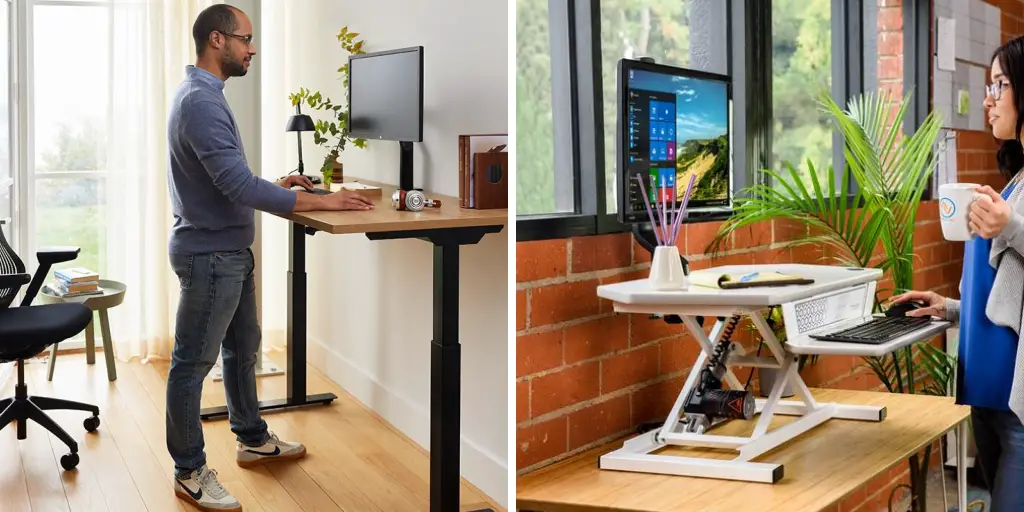In the era of sedentary lifestyles and prolonged hours spent at desks, the standing desk has emerged as a beacon of health-conscious work habits. As we increasingly recognize the detrimental effects of sitting for extended periods, the standing desk has gained popularity for its potential to alleviate back pain, improve posture, and boost overall well-being. Transitioning to a standing desk, however, requires more than just swapping out your chair for an elevated surface.

It demands a thoughtful approach to ergonomics and a commitment to adopting new habits. This article explores how to stand standing desk – from proper desk height and monitor positioning to the importance of ergonomic accessories.
Whether you’re a seasoned standing desk enthusiast or contemplating the switch, mastering the nuances of standing while working is essential for unlocking the full spectrum of health benefits this innovative desk solution promises. Join us on a journey to discover the keys to standing desk success and revolutionize your workspace for a healthier, more dynamic workday.
What Is a Standing Desk?
There has been a growing trend in recent years towards using standing desks as an alternative to traditional seated desks. This is partly due to the increased awareness of the negative health effects of prolonged sitting, and also because standing desks are believed to offer various benefits such as improved posture, increased calorie burn, and reduced back pain.
Benefits of Using a Standing Desk
Standing desks have become increasingly popular in recent years, and for good reason. These innovative workstations allow you to easily switch between sitting and standing positions while working, providing a wide range of health benefits. In this article, we will discuss how to stand at a standing desk to reap the maximum benefits.
Why Use a Standing Desk?
Before we dive into the proper way to stand at a standing desk, let’s first understand why it is beneficial to use one. Below are some of the key benefits of using a standing desk:

- Reduces Back Pain: Standing desks promote better posture and reduce strain on your back muscles, leading to less back pain.
- Boosts Energy and Productivity: Research has shown that standing while working can increase blood flow and oxygen to the brain, resulting in increased energy levels and improved focus.
- Improves Cardiovascular Health: Standing desks help reduce sedentary behavior, which is linked to an increased risk of heart disease. By standing more throughout the day, you can improve your overall cardiovascular health.
- Burns Calories: Standing while working burns more calories compared to sitting. In fact, research indicates that standing can increase calorie expenditure by up to 30%.
- Reduces the Risk of Weight Gain and Obesity: Standing desks encourage movement and discourage prolonged sitting, which has been linked to weight gain and obesity.
10 Methods How to Stand Standing Desk
1. Adjust the Height
The first step to using a standing desk is to adjust the height to your comfort level. The ideal height should allow you to stand with your arms at a 90-degree angle while typing on your keyboard. This will help prevent strain on your wrists and shoulders.
2. Use a Footrest
Using a footrest can help alleviate any discomfort or fatigue in your feet and legs while standing at your desk. It can also promote proper posture by keeping your feet flat on the ground. Position the footrest so that your feet are comfortably resting on it while standing. Avoid crossing your legs or using a footrest that is too high or too low, as this can lead to strain and discomfort in your legs.
3. Take Frequent Breaks

Even when using a standing desk, it’s important to take frequent breaks throughout the day. This will give your body a chance to rest and prevent any muscle strain from prolonged standing. Experts recommend taking a 5-minute break every hour, where you can sit down or take a short walk. This will help improve blood circulation and prevent fatigue.
4. Wear Comfortable Shoes
Wearing comfortable shoes is essential when using a standing desk. Avoid high heels or shoes with no support, as they can cause discomfort and lead to poor posture. Instead, opt for shoes with good cushioning and support.
You can also consider purchasing an anti-fatigue mat to stand on while using your standing desk. This will help reduce the pressure on your feet and joints, making it easier to stand for extended periods of time.
5. Incorporate Movement
Standing desks are meant to encourage movement, so don’t be afraid to incorporate some simple exercises into your routine. You can do calf raises, shoulder rolls, or even take short walks around the office. This will help improve your overall health and productivity.
6. Use an Anti-Fatigue Mat
Standing for long periods of time can put pressure on your feet and joints, leading to fatigue and discomfort. Using an anti-fatigue mat under your feet can provide cushioning and support, making it easier to stand for longer periods.
These mats are designed to reduce the impact on your muscles and joints, and can also help improve blood circulation in your legs. When choosing an anti-fatigue mat, look for one that is thick enough to provide adequate support, but not too thick that it becomes unstable. Additionally, make sure the mat is non-slip to prevent any accidents while standing.
7. Keep Good Posture

When using a standing desk, it’s important to maintain good posture. Keep your shoulders back and chest open, and avoid hunching over or leaning too far forward.
Your feet should be shoulder-width apart and your weight evenly distributed between them. Don’t lock your knees or overextend your legs, as this can put strain on your joints. Remember to take breaks to stretch and move around, and adjust the height of your desk as needed.
8. Use an Ergonomic Chair
Having an ergonomic chair nearby is helpful for when you need a break from standing or when you want to switch between sitting and standing throughout the day. When choosing an ergonomic chair, look for adjustable seat height and lumbar support for the best comfort and posture. Additionally, choose a chair with swivel capabilities to easily move around your workspace.
9. Stand in Front of Your Desk
Make sure you are standing directly in front of your desk, with your arms comfortably resting on the surface. This will help prevent any strain on your neck or shoulders. Distribute your weight evenly between your feet, and make sure you are standing with good posture.

10. Listen to Your Body
Lastly, it’s important to listen to your body and adjust as needed. If you start feeling discomfort or fatigue, take a break or adjust the height of your desk. Everyone’s body is different, so find what works best for you and stick with it. Remember, the goal is to improve your health and productivity, not cause more harm.
Proper Body Alignment
Standing desks have become increasingly popular in recent years due to their potential health benefits. However, simply standing at a desk is not enough; proper body alignment must also be maintained to reap these benefits. In this section, we will discuss how to stand at a standing desk correctly.
When standing at a standing desk, it’s important to keep your feet hip-width apart and your weight evenly distributed on both feet. This will help maintain stability and prevent strain on one side of the body.
Your knees should be slightly bent, not locked, to avoid putting unnecessary pressure on your joints. Keep your back straight with your shoulders relaxed and down. Avoid hunching over or arching your back too much.
Incremental Adjustments to Standing Time
As we all know, sitting too much can significantly impact our health. Fortunately, standing desks are becoming increasingly popular in the office setting as an alternative to the traditional desk and chair. However, simply switching from a seated position to standing for prolonged periods may not be enough to reap the full benefits of using a standing desk.
It is crucial to make incremental adjustments when transitioning from a sedentary lifestyle to incorporating standing periods throughout the day. This can help prevent potential discomfort or injuries that may arise from sudden changes in posture.
Incorporating Sit-Stand Intervals in Your Workday
As technology continues to become an integral part of our daily lives, the amount of time we spend sitting at a desk has increased dramatically. This sedentary lifestyle can have negative effects on our health, leading to issues such as obesity, back pain, and even cardiovascular disease.

One solution to combat this is by incorporating sit-stand intervals into our workday. This involves using a standing desk, which allows you to easily switch between sitting and standing positions while you work. In this article, we will discuss how to stand at a standing desk and the benefits it can bring to your overall health.
Common Mistakes to Avoid when Standing at a Desk
Mistake #1: Standing for Long Periods of Time
One common misconception about standing desks is that one should stand all day long while working. However, this is not the case. Just like sitting for extended periods of time can be harmful, so can standing for too long. It is important to find a balance between sitting and standing throughout the day.
Mistake #2: Poor Posture
Another mistake that people make when using standing desks is not maintaining proper posture. It is important to stand up straight with shoulders back and feet shoulder-width apart. This will help prevent any strain on the back, neck, and shoulders. It is also recommended to use a footrest or an anti-fatigue mat to help with balance and support.
Mistake #3: Not Adjusting the Desk Properly
Standing desks come with adjustable heights for a reason. It is essential to adjust the desk to the correct height in order to maintain proper posture while working. An incorrect desk height can lead to discomfort and strain on the body. The correct height should allow for the elbows to be at a 90-degree angle while typing.
Mistake #4: Neglecting Movement
While standing is better than sitting, it is still important to incorporate movement into your workday. Standing in one spot for extended periods of time can lead to muscle fatigue and stiffness. Take short breaks to walk around, stretch, or do some light exercises.
Conclusion
In conclusion, standing desks are a wonderful tool for improving your health and productivity in the workplace. By following these tips on how to stand standing desk, you can make sure that your standing desk experience is comfortable and beneficial for your body. Remember to adjust the desk to fit your height, have proper footwear and take breaks to stretch and move around.
Don’t forget to maintain good posture and alternate between sitting and standing throughout the day. By incorporating these practices into your daily routine, you will reap the benefits of increased energy, focus, and overall well-being. So what are you waiting for? Go out there and start making use of that standing desk! Your body will thank you for it in the long run. Happy standing!
